The Nexus 7 (2013) Review
by Anand Lal Shimpi on August 22, 2013 6:00 PM EST
Truth be told, Google has made (or at least directed the making of) some of the best tablets on the market today. The original Nexus 7 was groundbreaking in that it offered a totally usable platform, married to the latest version of Android, for $199. The Nexus 10 gave us a very quick, ultra high resolution 10-inch tablet for $100 less than the flagship iPad (and with more storage). Both were easily recommendable due to their value, but this year Google is stepping out of the shadow of value and into one of excellence. It starts with the new Nexus 7.
Based on the success of the original Nexus 7, Google went back to ASUS for the second version. In the 12 months since the release of the Nexus 7, the world has changed quite a bit. Expectations for value tablets had been reset by the original Nexus 7 as well as Amazon's lineup of Kindle Fires. Simply showing up with another good value likely wouldn't do anything to further the brand (or market). I get the distinct impression that Google isn't big on not changing the world.
| Nexus 7 Tablet Specification Comparison | ||||
| ASUS Nexus 7 (2012) | ASUS Nexus 7 (2013) | |||
| Dimensions | 198.5 x 120 x 10.45mm | 200 x 114 x 8.65mm | ||
| Chassis | Plastic + Rubber back | Plastic + Soft Touch back | ||
| Display | 7-inch 1280x800 IPS | 7.02-inch 1920x1200 IPS | ||
| Weight | 340 g | 290 grams (WiFi), 299 grams (LTE) | ||
| Processor | 1.3 GHz NVIDIA Tegra 3 (T30L - 4 x Cortex A9) | 1.5 GHz Qualcomm Snapdragon S4 Pro (APQ8064-1AA) | ||
| Memory | 1 GB | 2 GB DDR3L | ||
| Storage | 8 GB / 16 GB | 16 GB / 32 GB | ||
| Battery | 16 Whr | 15.01 Whr | ||
| WiFi/Connectivity | 802.11b/g/n, BT, NFC | 802.11a/b/g/n, BT 4.0, NFC | ||
| Camera | 1.2MP Front Facing |
5.0 MP Rear Facing w/AF 1.2MP Front Facing |
||
| Wireless Charging | – | Yes (Qi Compatible) | ||
| Pricing | $199/$249 |
$229/$269 (WiFi 16/32 GB) $349 (LTE) |
||
The result is the new Nexus 7. Identical only in name, manufacturer and screen size, the 2013 Nexus 7 is a downright Apple way to rev a product. Google made it thinner, lighter, faster and better in almost every way.

2013 Nexus 7 (left) vs. 2012 Nexus 7 (right)
The original Nexus 7 was rather thick but it got away with it since the overall footprint of the tablet was so small. The new Nexus 7 truly feels like a slate. It's the type of thing I expect to see carried around on the Enterprise.
I don't miss the rubber imitation leather from the original Nexus 7, it's replaced by a soft touch plastic back. You definitely don't get the premium aluminum feel of the iPad mini, but the device doesn't feel cheap either. The new Nexus 7 is still nice enough that I'm nervous about scratching or scuffing the back.
Both ASUS and Nexus logos are prominently featured on the back. ASUS continues to amaze me by just how far it's come as a company, and the new Nexus 7 is hands down its most impressive tablet creation yet. From a build quality standpoint I really have no complaints about the Nexus 7. While the MeMO Pad HD7 has some creaks and flex in the chassis, the new Nexus 7 feels like a solid slab of soft plastic and glass. It's nice.
Unlike the original Nexus 7, the new model features stereo speakers on back of the tablet. It's an easy feature to take for granted but going back to the old mono design sounds worse.
I agree with Brian that the power/lock and volume buttons are the only real sore spot on the physical execution. They aren't particularly well defined and feel a bit mushy. Even writing this paragraph feels like I'm nit picking though, the build here is really good.
The only other complaint I'd levy against the new Nexus 7 is that the design doesn't particularly stand out as being unique. The iPad has its aluminum, the Moto X has its wood, but the Nexus 7 falls victim to the fact that ultimately it's tough to make these ultra mobile devices stand out. You need a large glass surface and you need a back. Black also tends to be one of the easier colors to sell (get too creative and you end up with inventory problems). It's not a huge deal to me personally, but as mobile devices can often be fashion statements I don't know that the new Nexus 7 has all that much curb appeal.
The Display
What the Nexus 7 lacks in pizazz, it completely makes up for once you power on the display. The 7-inch 1920 x 1200 display produces colors that are not only vibrant but, for the first time ever in a Nexus device, accurate as well. Google really worked on color accuracy this time, with a two step calibration process - once at a high level by the panel maker and once again per device during final manufacturing. The result is just awesome:
The Nexus 7 display is not only visually appealing but stacks up incredibly well in our CalMAN display tests. Although it loses to the iPad 4, the Nexus 7 gets indiscernibly close in many cases and blows the non-Retina iPad mini out of the water. I won't even bother comparing it to everything else in the Android space, they don't hold a candle to it.
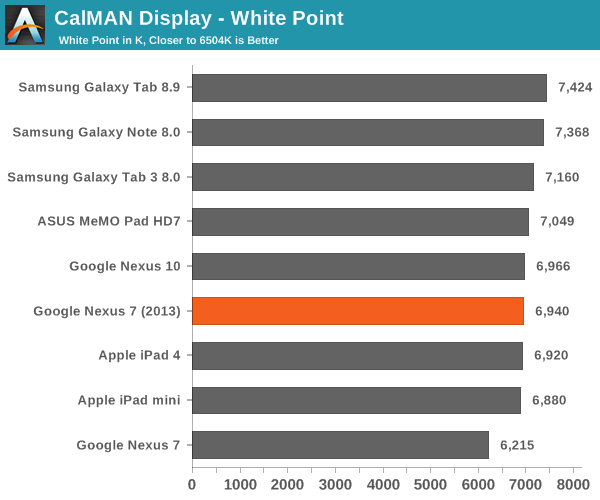
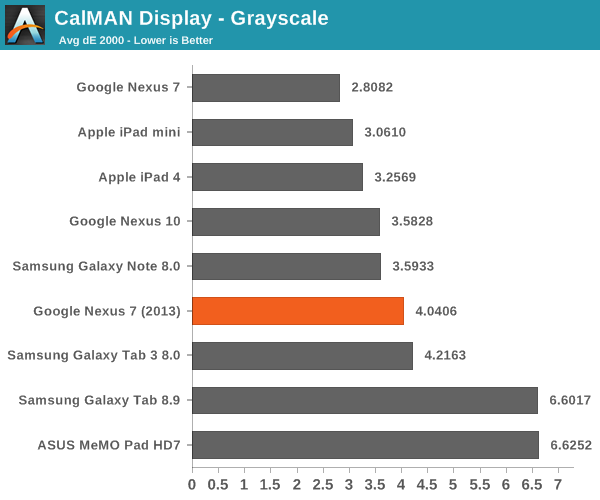
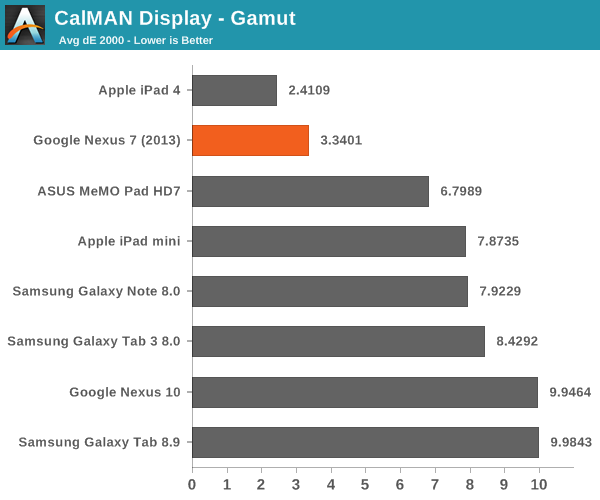
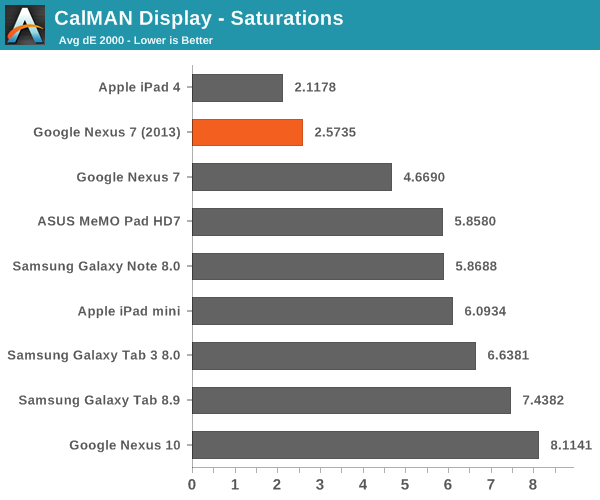
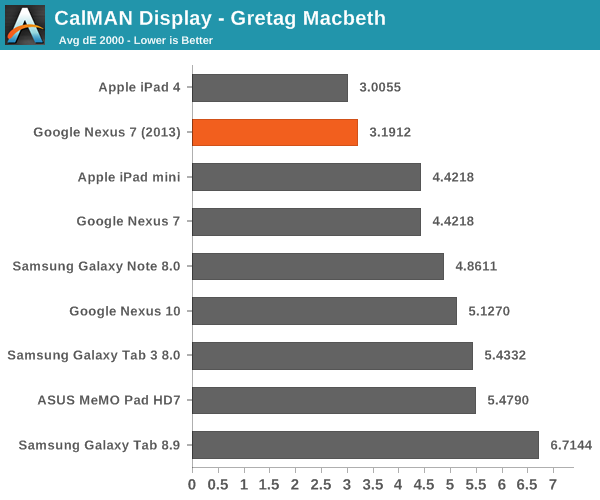
The new panel is also incredibly bright. I typically view 500 nits as the threshold for outdoor usability, and the new Nexus 7 definitely exceeds that threshold. The tablet will drink away all of your battery life if you leave it at this brightness setting indefinitely, but if you need to actually use your tablet outdoors for a while the Nexus 7 works.

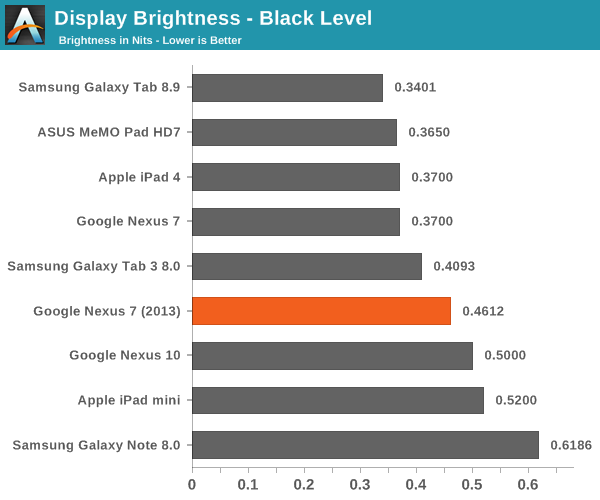
Black levels are a bit higher than on the original Nexus 7, but the resulting peak contrast ratio is still excellent:
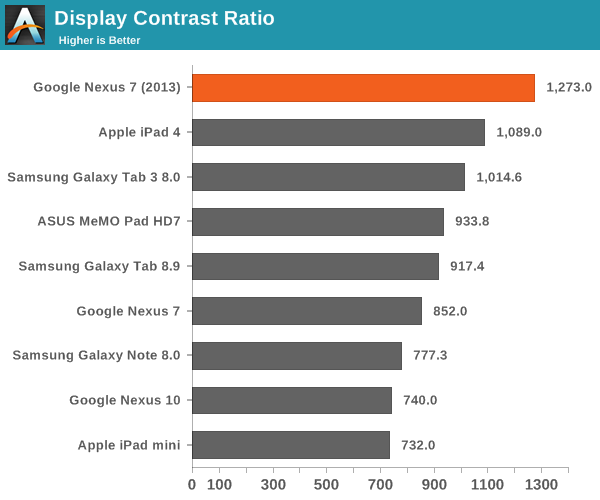
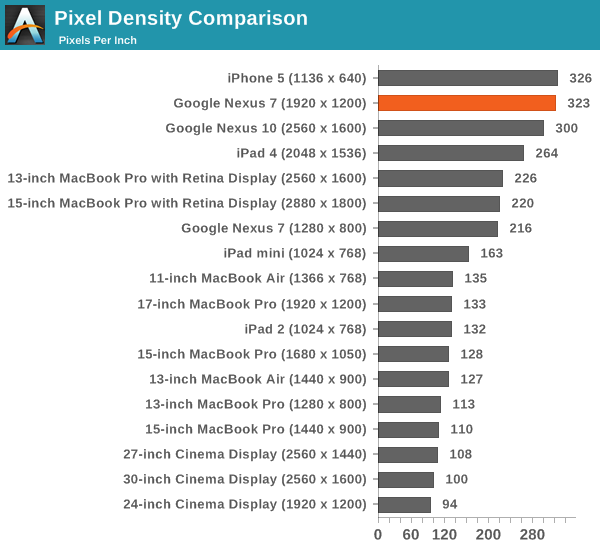
Pixel density shoots through the roof with the new Nexus 7 display as well. Brian was quick to point out that a major advantage of the Android platform is in its flexible resolution handling. The 1920 x 1200 panel presents itself as a 960 x 600 panel to web pages in Chrome, while other apps can use every last pixel for unique content (e.g. games).
The beauty of not having to double the original Nexus 7's resolution but instead settling on an in-between option like 1920 x 1200 is that Google could get away with a performance mainstream SoC instead of something ridiculously high-end.
The display looks great when viewing everything from photos and movies to web pages and eBooks. My only complaint about the Nexus 7's display is its size. A 7-inch tablet is almost pocketable (in fact I did carry it around in my pocket for a day), but the screen can feel a little cramped.


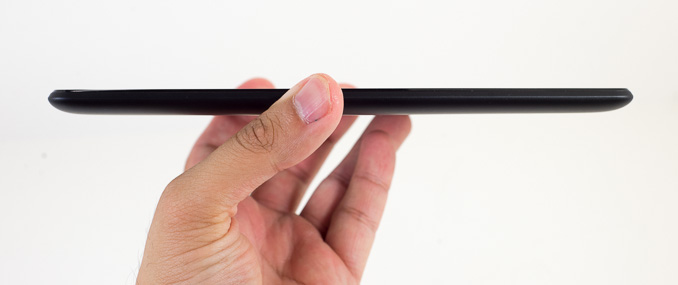
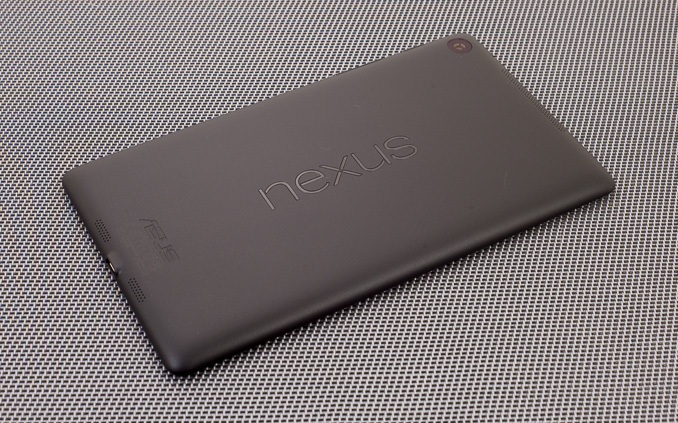
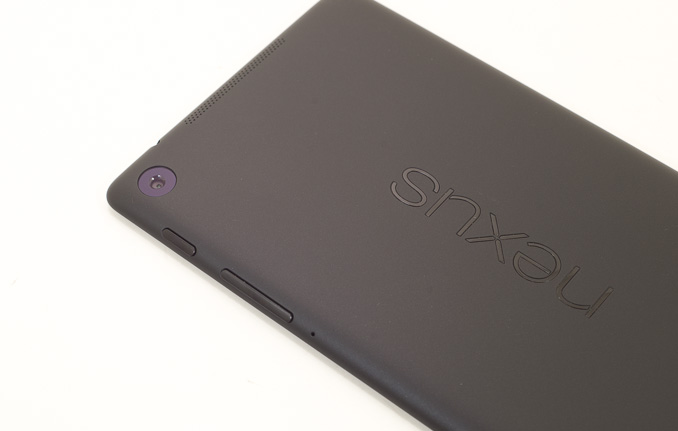


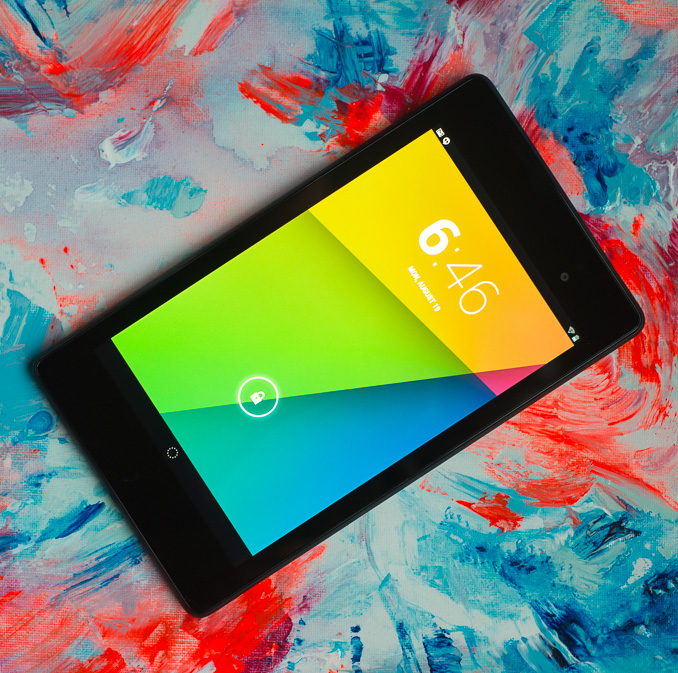
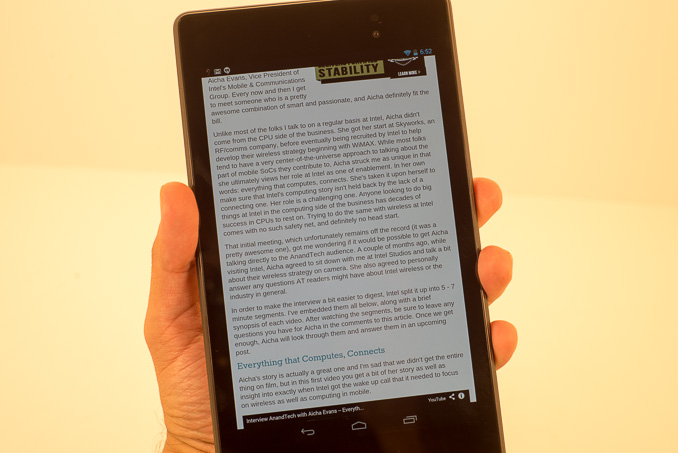
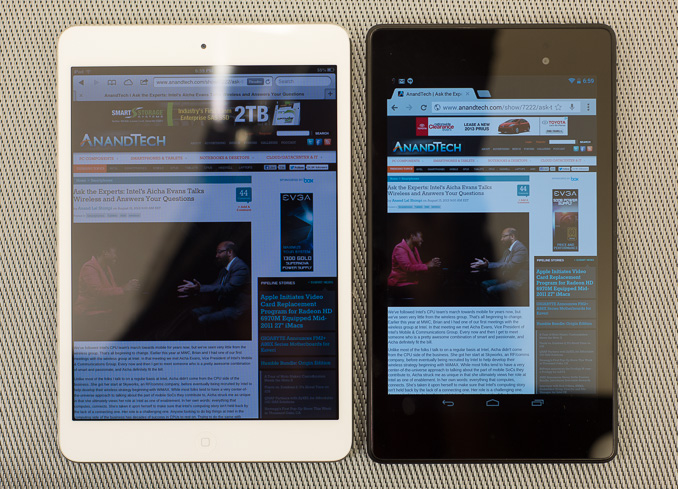








202 Comments
View All Comments
JDG1980 - Thursday, August 22, 2013 - link
This is Anandtech, not the Wall Street Journal. Why are the business strategies of these companies relevant to who provides the best device at the best price? Why should consumers care who is subsidizing what?BMNify - Thursday, August 22, 2013 - link
Copy pasting from my above comment as you didn't go through it: If subsidised hardware kill off the hardware manufacturer's then you will be left with a monopoly that is Google who can charge you more later and make money on Ad's too like they do now. This is the reason why selling at-cost or dumping is not desirable.smartypnt4 - Thursday, August 22, 2013 - link
Interesting perspective. I hadn't heard a well-reasoned argument against selling at or near cost before now. Also, do you have a source to back up the claim that ASUS is making a significantly smaller margin on the N7 than they are on their other devices? Their MemoPad HD 7 is a 2012 N7 clone that's $150, so if the 2013 N7 is at cost, that has to be as well. And that's not being subsidized by Google, so if it were really at cost without some hypothetical Google subsidy, why would ASUS bother designing and selling it?psyside1 - Friday, August 23, 2013 - link
Thanks alot Anand, for listening us, and put the 16 vs 32GB version in your review, now i know i want the 32GB version! fanstastic review.ASEdouardD - Friday, August 23, 2013 - link
I know it's a great thing to add in the review, but I would frankly would have preferred not to know! As I bought the 16 GB model, hehe. Doubt it has a big impact on real world use though.akdj - Sunday, August 25, 2013 - link
Google most likely pays ASUS to make the tablet....they pay the price of the BOM & labor directly to ASUS. That's how they are making their money. Google is essentially giving the tablet away for you, and everything that IS you. Your friends. Your contacts. Your email. Your documents and music and movies....and, what they call the 'data mine'. They sell that info to third party companies and probably double their original $200 investment to ASUSsmartypnt4 - Sunday, August 25, 2013 - link
According to what evidence? It's widely known that Apple takes a very large margin on their products, which the Mini being the lowest margin (~40% if I remember correctly). There has been no indication of what the Nexus 7 actually costs to build. My point is that ASUS is selling their own tablets without Google at prices that make me think that the Nexus 7 isn't actually being sold at or under cost. I'm thinking it's probably relatively low-margin compared to the iOS devices, but everything in technology is low margin compared to iOS stuff (except Intel processors, that is).And yes, Google uses your information to target ads at you. That's not really news to anyone, and anyone buying into Android better know and be OK with that, or just not care.
amdwilliam1985 - Monday, August 26, 2013 - link
Thanks for the insight info about Google spying on us. Let's run the other way, Apple/M$ are so great and never touch our private sensitive data. Our data sitting in icloud/skydrive are so magical that nothing comes and tint it. Oh just how I love facebook is doing everything they can to make us feeling safer/happier about posting everything onto it. man oh man, the 21st century is all about Google mining your/our data and every other companies protecting you/us ;) /sSarcastic off, man grow up, crying about Google spying on you, lol. The way I see it is that if they're going to data mine us one way or the other, why not benefit from it? Why pay for your device twice? Once in privacy and once in physical dollar. I'm going with the one that I think is the least evil of them all, Google. Yes, I've used apple products before, didn't like how restricted iphone/ipad are. Didn't like how macbook air can't install the programs that are only running in windows, sigh...
Mivo - Friday, August 23, 2013 - link
You should probably post some sources for your claims. That aside, what is and is not desireable is a matter of perspective. I'd wager that most end customers are fine with ads or a walled garden, if that substantially lowers the price of a device. Just look at Amazon and their customers. (Or look at Apple and their customers who happily pay premium prices in spite of the walled garden.)Ananke - Friday, August 23, 2013 - link
Example: Asus buys from Foxconn at $220, and sells for $229. If it costs Foxconn 29.99 to manufacture and sell to Asus, is it considered "sold almost at cost" to end users by your logic?